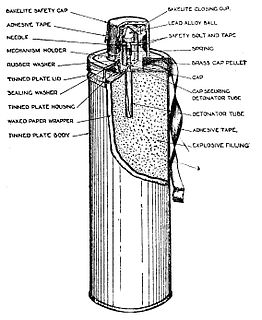 W
WThe Gammon bomb, officially known as the No. 82 grenade was a British hand grenade used during World War II.
 W
WThe Grenade, Hand, Anti-Tank, No. 75, also known as the "Hawkins grenade" was a British anti-tank hand grenade used during World War II. It was one of a number of grenades developed for use by the British Army and Home Guard in the aftermath of the Dunkirk evacuation. The grenade first appeared in 1942, and was designed to be more versatile than previous grenades, such as the No. 73 grenade and the sticky bomb.
 W
WThe HG 85 is a round fragmentation hand grenade designed for the Swiss Armed Forces and still produced by RUAG Ammotec in Switzerland. HG 85 is the internal designation of the Swiss Army and replaces the HG 43 from WWII.
 W
WThe double cylinder, Nos. 8 and No. 9 hand grenades, also known as the "jam tins", are a type of improvised explosive device used by the British and Commonwealth forces, notably the Australian and New Zealand Army Corps (ANZAC) in World War I. The jam tin, or bully beef tin, was one of many grenades designed by ANZACs in the early part of the First World War in response to a lack of equipment suited to trench warfare.
 W
W"Mills bomb" is the popular name for a series of British hand grenades. They were the first modern fragmentation grenades used by the British Army and saw widespread use in the First and Second World Wars.
 W
WThe Grenade, Hand, No. 1 was the first British hand grenade used in World War I. It was designed in the Royal Laboratory, based on reports and samples of Japanese hand grenades during the Russo-Japanese War provided by General Sir Aylmer Haldane, who was a British observer of that war.
The British No. 69 was a hand grenade developed and used during the Second World War. It was adopted into service due to the need for a grenade with smaller destructive radius than the No. 36M "Mills bomb". This allowed the thrower to use a grenade even when there was little in the way of defensive cover. In contrast, the much greater destructive radius of the Mills bomb than its throwing range forced users to choose their throwing point carefully, in order to ensure that they would not be wounded by the shrapnel explosion of their own grenade.
 W
WThe No. 73 grenade, also known as the "Thermos", "Woolworth bomb", or "hand percussion grenade", was a British anti-tank grenade used during the Second World War. It got its nickname from the resemblance to a Thermos flask.
 W
WThe "Grenade, Hand, Anti-Tank No. 74", commonly known as the S.T. grenade or sticky bomb, was a British hand grenade designed and produced during the Second World War. The grenade was one of a number of ad hoc anti-tank weapons developed for use by the British Army and Home Guard after the loss of many anti-tank guns in France after the Dunkirk evacuation.